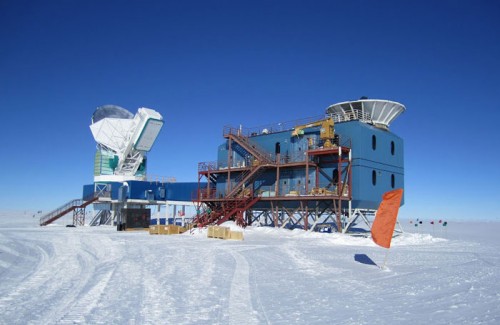
Researchers working on the BICEP2 telescope announced on Monday that they had detected the first evidence for the primordial B-mode polarization of the cosmic microwave background. (Courtesy: National Science Foundation)
By Michael Banks
This week has seen physics news hit the mainstream in a way not seen since the Higgs boson was discovered at the CERN particle-physics lab in 2012.
On Monday, researchers working on the Background Imaging of Cosmic Extragalactic Polarization (BICEP2) telescope at the South Pole revealed that they have detected the first evidence for the primordial B-mode polarization of the cosmic microwave background (CMB). You can read our news stories about the finding here and here.
Yet could scientists in the UK have got there first if a telescope they had been planning to build – dubbed Clover – hadn’t been axed in 2009?
In 2007 UK physicists and astronomers were hit by a massive funding crisis that engulfed one of the country’s main funding agencies: the Science and Technology Facilities Council (STFC). The £80m black hole in the STFC’s budget forced the council to stop supporting research into the International Linear Collider, withdraw from the Gemini telescopes in Hawaii and Chile, as well as slashing grants for researchers in particle physics and astronomy.
The fallout from the crisis was felt for a number of years afterwards (some would say it still is today) and was followed by a host of “programmatic reviews”, which ranked projects against each other and sometimes resulted in the cancellation of lower-priority facilities.
Although Clover was actually deemed to be of “high importance” by the STFC in a 2008 review, it didn’t escape the chop, which happened in March 2009. The reason given by the STFC was because construction costs had risen by 60% to some £7.5m.
A collaboration between Cambridge, Cardiff, Manchester and Oxford universities, the UK-led telescope, which would have been located in the in the Atacama Desert in Chile, was designed to search for exactly what BICEP2 discovered this week.
Michael Jones, an experimental cosmologist at Oxford who was an instrument scientist for Clover, told physicsworld.com that while the BICEP2 results are “very exciting” but need to be confirmed by other telescopes, he bemoans the fact that Clover could have been one of those experiments now at the forefront of B-mode research.
“It was very clear back when Clover was cancelled that this day was going to arrive – everyone in the field recognizes the importance of the B-mode measurement, and everyone knew that when or if it was discovered, then it was going to be front-page news,” says Jones. “The fact that it seems to have been measured at such a high level means that Clover would definitely have been able to detect it. Of course, we can’t say whether or not Clover would have been first, but even if Clover hadn’t been first, it would have been part of what is now a highly important field.”
Of course, UK researchers are still involved in BICEP2, with Cardiff University a collaborating member of the telescope, and other experiments now in the hunt for B-modes such as Polarbear and the European Space Agency’s Planck mission.
But that seems scant consolation given the possibility that the UK might have got there first. “It is certainly worth pointing out that the STFC made the decision to pull the UK out of a field of unquestioned scientific importance, in which we had a leading position, to save what in retrospect seems to be quite a small amount of money,” adds Jones.
Indeed,a spectacular possibilities with the bicep2,great for all science sector…great importance.
Nice story, but Clover actually got canned because the team couldn’t get their act together, not to save money. Great shame, they could have been first.